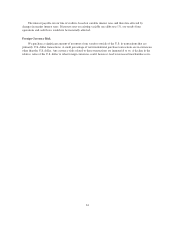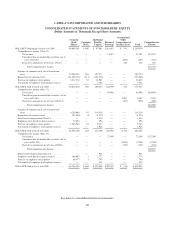Cabela's 2005 Annual Report Download - page 72
Download and view the complete annual report
Please find page 72 of the 2005 Cabela's annual report below. You can navigate through the pages in the report by either clicking on the pages listed below, or by using the keyword search tool below to find specific information within the annual report.
ITEM 7A. QUANTITATIVE AND QUALITATIVE DISCLOSURES ABOUT MARKET RISK
We are exposed to interest rate risk through our bank’s operations and, to a lesser extent, through our
merchandising operations. We also are exposed to foreign currency risk through our merchandising operations.
Financial Services Interest Rate Risk
Interest rate risk refers to changes in earnings or the net present value of assets and off-balance sheet
positions less liabilities (termed “economic value of equity”) due to interest rate changes. To the extent that
interest income collected on managed loans and interest expense do not respond equally to changes in interest
rates, or that rates do not change uniformly, securitization earnings and economic value of equity could be
affected. Our net interest income on managed credit card loans is affected primarily by changes in short term
interest rate indices such as LIBOR and prime rate. The variable rate credit card loans are indexed to the prime
rate. Securitization certificates and notes are indexed to LIBOR-based rates of interest and are periodically
repriced. Certificate of deposits are priced at the current prevailing market rate at the time of issuance. We
manage and mitigate our interest rate sensitivity through several techniques, but primarily by modifying the
contract terms with our cardholders, including interest rates charged, in response to changing market conditions.
Additional techniques we use include managing the maturity, repricing and distribution of assets and liabilities
by issuing fixed rate securitization certificates and notes and by entering into interest rate swaps to hedge our
fixed rate exposure from interest strips. The table below shows the mix of account balances at each interest rate
at fiscal year end 2005, 2004 and 2003.
Fiscal Year
2005 2004 2003
As a percentage of total balances outstanding
Balances carrying interest rate based upon the national prime lending rate ...... 58.0% 57.2% 58.1%
Balances carrying an interest rate of 9.99% .............................. 3.0% 3.1% 3.8%
Balances carrying an interest rate of 0.00% .............................. 0.1% 0.0% 0.0%
Balances not carrying interest because their previous month’s balance was paid
in full .......................................................... 38.9% 39.6% 38.1%
Charges on the credit cards issued by our Financial Services segment are priced at a margin over the defined
national prime lending rate, subject to certain interest rate floors, except purchases of Cabela’s merchandise,
certain other charges and balance transfer programs, which are financed at a fixed interest rate of 9.99%. No
interest is charged if the account is paid in full within 20 days of the billing cycle.
Management has performed an interest rate gap analysis to measure the effects of the timing of the repricing
of our interest sensitive assets and liabilities. Based on this analysis, we believe that if there had been an
immediate 100 basis point, or 1.0%, increase in the market rates for which our assets and liabilities are indexed
during the next twelve months, our projected operating results would not be materially affected. Management
also has performed a projected interest rate gap analysis for the same future twelve month period to measure the
effects of a change in the spread between the prime interest rate and the LIBOR interest rate. Based on this
analysis, we believe that an immediate 50 basis point, or 0.5%, decrease or increase in this spread would cause a
decrease or increase of $3.7 million to $3.9 million on the projected pre-tax income of our Financial Services
segment over the next twelve months, which could have a material effect on our operating results.
Merchandising Interest Rate Risk
One of our economic development bond agreements is priced at a variable interest rate with its base rate tied
to prime rate and adjusted annually in November. Changes in the prime rate from November 2004 to November
2005 increased our interest income by approximately $0.4 million. The change in rate at November 2005 will
increase interest income in 2006 by approximately $1.3 million. Interest rate changes on our variable rate bonds
could have a material impact on our pre-tax income.
60
























